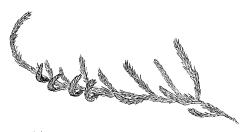Description as per Ischyrodon lepturus:
Plants small or medium-sized, lustrous, pale or dark green, forming loosely interwoven mats. Stems c. 10–30 mm, creeping and curving upwards from the substrate, subpinnately or irregularly branched, with fascicles of smooth, pale brown rhizoids at leaf bases, in cross-section with an ill-defined central strand and c. 3 layers of firm-walled, irregular cortical cells. Branches variable in length, mostly c. 3–8 mm but sometimes longer (to c. 20 mm), erect-ascendant and mostly strongly curved. Stem leaves erect-spreading or occasionally weakly complanate, (1.2–)1.5–2.0 × (0.45–)0.6–0.8 mm (excluding the smaller leaves near the stem apex), differing from branch leaves only by size. Branch leaves erect-spreading, ovate or ovate-lanceolate, gradually narrowed to a concolorous acuminate apex, concave and narrowed at base, often with one weak basal plication extending c. ⅓ –½ the leaf length, 0.8–1.4 × 0.4–0.5 mm; margins entire or less often weakly crenulate or with a few weak teeth, weakly reflexed at base on one or both sides, plane above; upper laminal cells linear, pointed at both ends, smooth, c. (45–)60–75(–90) × 6–7 µm; alar cells strongly differentiated, quadrate or oblate, mostly 9–13 µm wide, not porose, forming a large, opaque, and strongly concave group extending to and covering (on the adaxial surface) the costal base and (17–)20–30 cells up the margin. Costa stout and well-defined at base, strongly tapered, extending ½(–¾) the leaf length. Paraphyllia absent.
Dioicous. Perichaetia not seen. Perigonia scattered on ventral surface of stems, gemmiform, the perigonial leaves shorter (c. 0.5 mm) than vegetative and scarcely costate. Capsules not seen.
A monotypic or doubtfully ditypic genus occurring in Australasia and South Africa. Ischyrodon is separated from Fabronia by differences in sexuality, by having longer ± entire leaves with reflexed margins and linear upper laminal cells, and, reportedly, by having larger peristome teeth. The two genera occupy quite different habitats in N.Z.
| Category | Number |
|---|---|
| Indigenous (Non-endemic) | 1 |
| Total | 1 |




